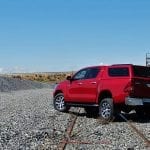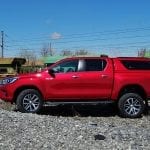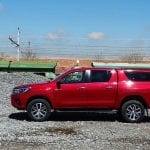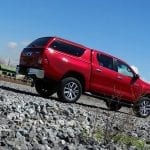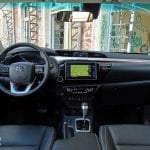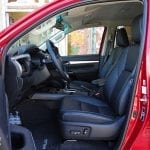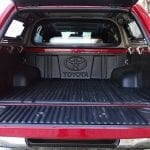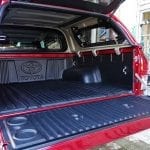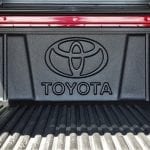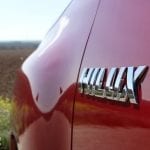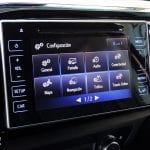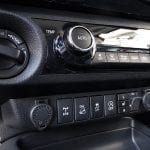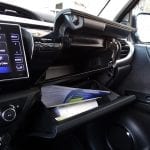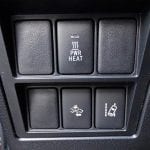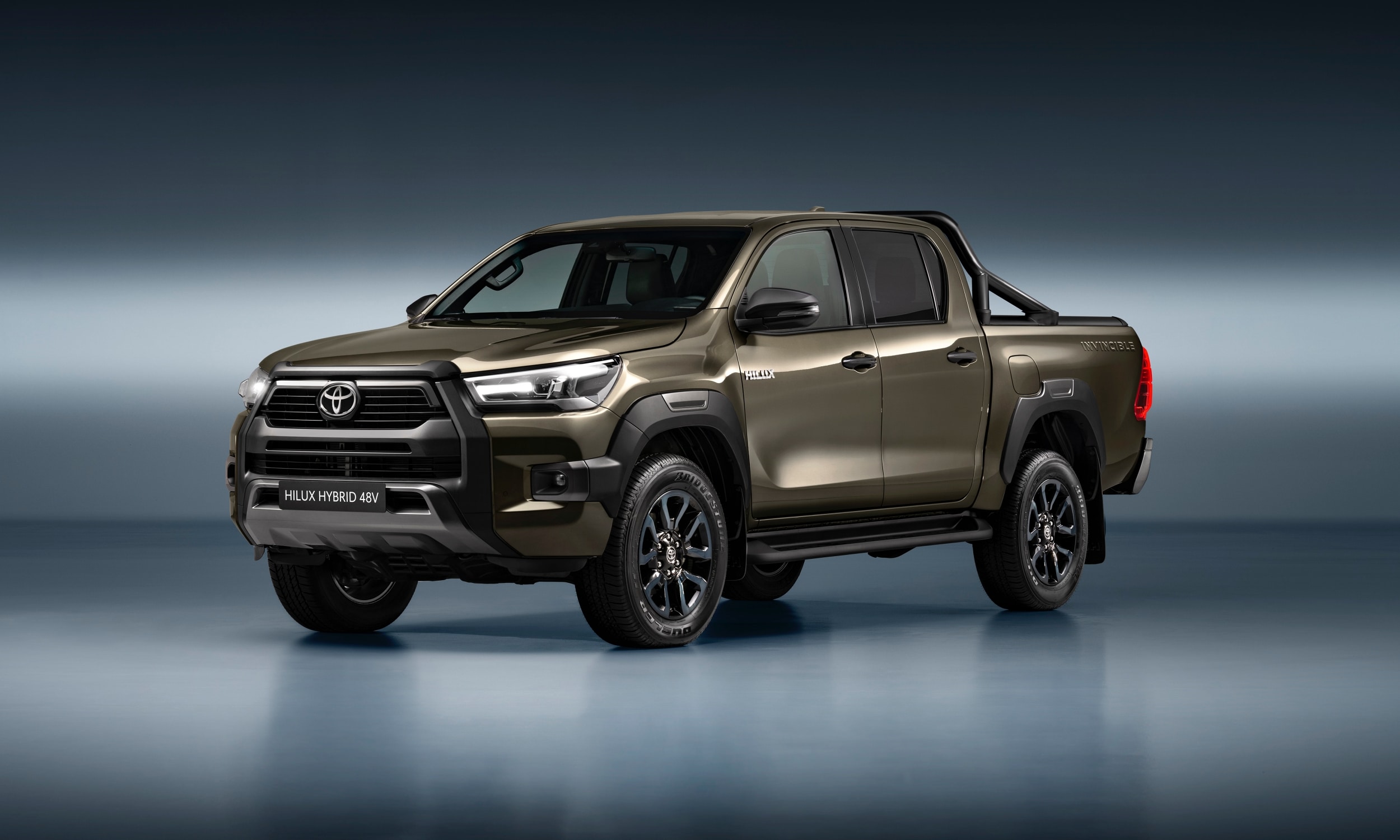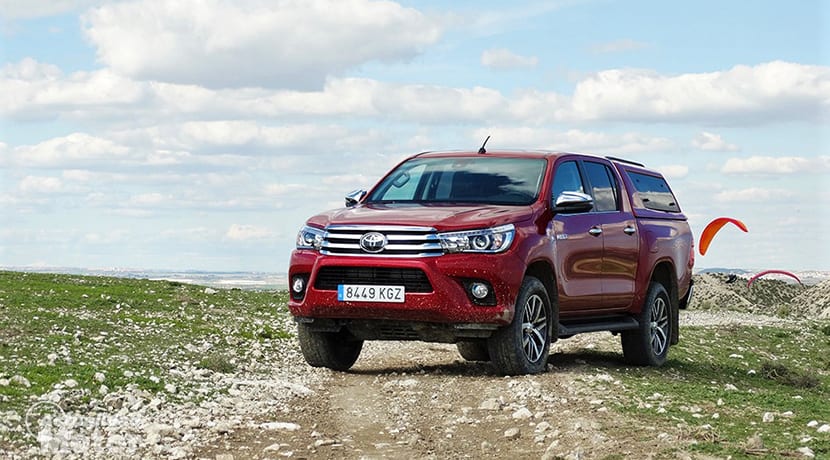
50 years has been working Toyota Hilux, having sold more than 18 million units throughout the world of the eight generations that have seen the light in this half century of life. At the beginning of this year 2018, the Japanese brand Toyota made a slight update on this model. With hardly any cosmetic changes, the update carried out on this model focuses on equipment upgrades and, in turn, a greater differentiation between the versions for professional use and those for private use.
These improvements, among other things, have been motivated by the new legislation arrived in Spain recently, which allows this type of vehicle can travel at a maximum speed of 120 km/h on highways and motorways; that is, now pick-ups have the same maximum speed limits as a car. Thus, without further ado, we begin this test with the Toyota Hilux 2018, using the bodywork Double Cabin, the level of equipment Limited and the mechanical variant 4 hp D-150D with automatic transmission.
Robust, but with a modern design

This Limited finish dresses the Toyota Hilux in a very elegant way thanks to some specific details, although the robust lines are common throughout the range. Thus, on the front we find a large chrome grill composed of horizontal slats and which, without a doubt, is the center of attention. At their sides are lodged the main headlights with a very modern design, which in this case uses LED lighting for short and halogen lamps for high beam. The fog lights use a circular design in the lower corners.
On the side of the body highlight the stylized 18-inch wheels and chrome finishes used on the mirror housings and on the door handles, details that give it a very elegant touch. Under the doors there is a footboard that facilitates access to the passenger compartment, while the inscription "Hilux" is present just below the rear-view mirrors. As you see, this unit comes with the box closed, which transforms its image into practically that of an all-terrain model and provides much more practicality.

Little can we highlight of his rear, because the pick-up condition means that practically all the models in this category are very similar in their rear. again we find chrome details, which appear both in the handle to open the lower hatch of the box and in the reinforced bumper. The pilots, as usual, are outside the cover of the box, except for the third brake light.
Successful interior design, but prepared for the war in the field
VXL and Limited trims make your interior design very similar to any tourism. Look at the image that we leave you just below this paragraph. Although it is true that interior plastics have a good visual presence and very successful fits, Toyota has preferred to maintain hard and robust finishes so that they are easy to clean and maintain a good appearance even over the years. And it is that, remember, we are facing a real all-terrain vehicle that will spend a lot of time dealing with dust and mud, so it is the most appropriate solution.
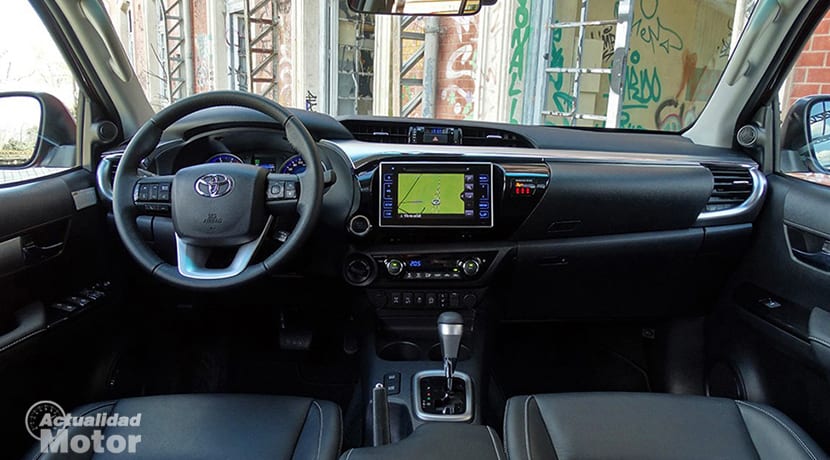
Despite this, the Japanese brand has not skimped when it comes to offering good equipment and with good quality perception. The best examples are found in the central area of the dashboard, where we find the touch screen with Toyota Touch 2 multimedia system, the start button, the controls for climate control and different buttons for traction management and off-road aids; but also in the leather upholstery of the seats.
A positive point is double glove box, with refrigeration on the top, as well as the large number of slide holes that, in addition, allow us to place large water bottles. We also have multiple power outlets and USB. We do not forget the instrument panel, which shows all the information correctly and which has a TFT screen between the two dials to project all the trip information.
Regarding space for the occupants, the front seats are quite spacious and comfortable, with electric regulation of the driver's seat and heating for both front seats. Per request, a little more depth regulation of the steering wheel would help the driver feel more comfortable with his driving position, but in the case of a pick-up this is not a big complaint.

In the second row we have three approved seats, also having leather upholstery. They are relatively comfortable, although it is also true that we ride with our backs straighter than usual. The space on the roof is sufficient, although in the central square it is a little tighter and people taller than 1,75 meters will begin to feel somewhat overwhelmed. The backrest of this fifth seat houses an armrest. A positive point is low transmission tunnel height, which is not very intrusive.
To finish this section, I will tell you about his box. As we saw before, we have a closed box, which provides much more versatility and allows you to leave an object in the cargo space without being in the eyes and reach of anyone. It is true that the tightness is not perfect, because during the test we a little dust and a drop has entered of water, but it grants many advantages. The windows are darkened and can be opened, both the sides and -logically- the rear that we find on the gate. Below I detail its dimensions.
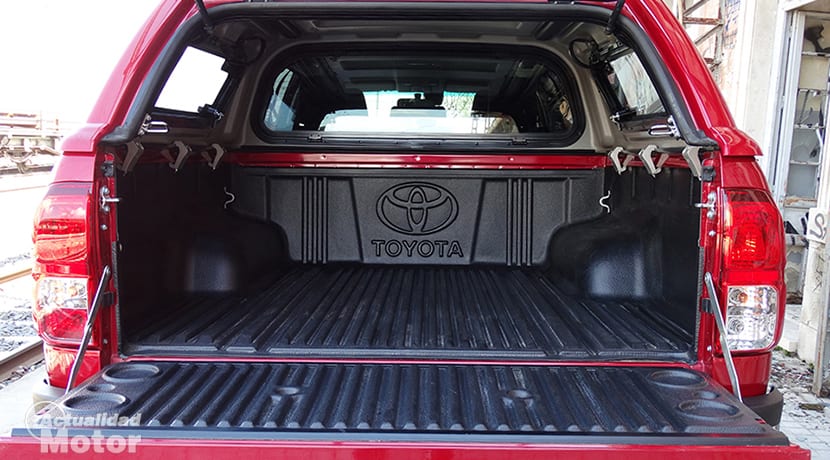
Bodywork, finishes and mechanics available in the Toyota Hilux
The Toyota Hilux is available with a single motor, although we can choose it with a six-speed manual transmission or with an automatic gearbox that simulates the same number of gear ratios. The propellant is a robust 2.4 diesel with variable geometry turbo and intercooler. develops a power of 150 CV at 3.400 rpm and a maximum torque of 340 Nm from 1.600 rpm.
Among the latests Moravia's compositions homologated benefits of the Toyota Hilux with double cabin and automatic transmission we find a maximum speed of 170 km/h and a 0 to 100 km/h in 12,8 seconds. It's faster in acceleration than the manual version (which takes 13,2 seconds), but it's also true that the automatic gets some higher approved consumption, 7,2 l/100 km for the automatic and 6,8 for the manual.
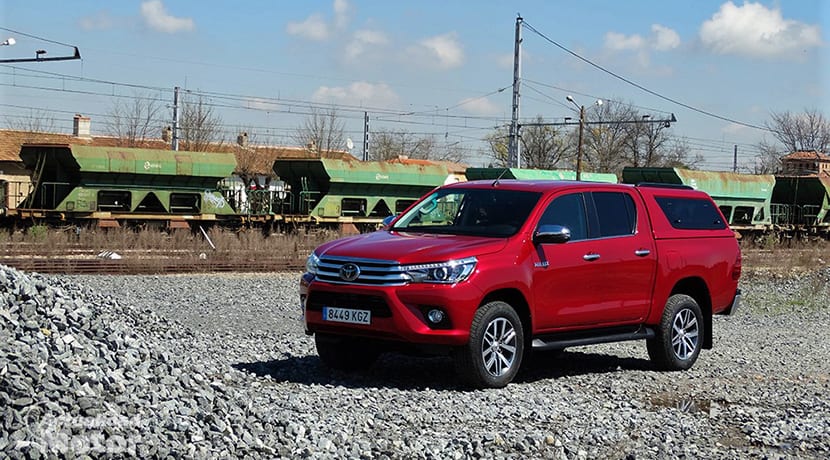
Regarding the bodies available in the Toyota Hilux, the Japanese model maintains its offer with the "single cabin", "extra cabin" and "double cabin". The first has an approved passenger compartment for only two people with a shorter cabin, the second is also a two-door although it has two rows of seats and four approved seats, and the double cabin (tested bodywork) has four doors and an interior capable of accommodate up to five occupants.
As for Finished, the Toyota Hilux is currently available with four levels of different equipment, which also significantly affect the aesthetics. The GX and VX variants have a professional approach and they incorporate reinforced springs to withstand higher loads and demanding tasks. more thought for private use are the VXL and Limited terminations, who opt for a more elegant aesthetic configuration and a more comfortable set-up. Below we detail the equipment of each variant.
Dimensions and capacities

In this type of vehicles It is important to know and take into account the dimensions of the bodywork, lower angles and, of course, load capacity.
| Single cabin | extra cabin | Double cabin | |
|---|---|---|---|
| Single cabin | extra cabin | Double cabin | |
| Length (mm) | 5.330 | 5.330 | 5.330 |
| Width (mm) | 1.800 | 1.855 | 1.855 |
| Height (mm) | 1.795 | 1.810 | 1.815 |
| Wheelbase (mm) | 3.085 | 3.085 | 3.085 |
| Ground clearance (mm) | 277 | 289 | 293 |
| angle of attack (degrees) | 30 | 31 | 31 |
| Departure angle (degrees) | 25 | 26 | 26 |
| Box length (mm) | 2.315 | 1.810 | 1.525 |
| Box width (mm) | 1.645 | 1.645 | 1.645 |
Behavior on asphalt of the Toyota Hilux

Pick-ups are not comfortable models for driving on asphalt, being more comfortable all-terrain to use. Most vehicles of this type use leaf springs as a spring in your rear suspension and somewhat soft shock absorbers, which means that, if we do not carry several tens of kilos loaded in the box, it rebounds somewhat abruptly. It is not necessary to pass a big pothole, but it is noticeable in practically any irregularity of the terrain. It is because of that passengers in the rear seats suffer more fatigue after a few miles of travel. In that sense, a Nissan Navara (here the test), which has Multi-Link rear suspension, is much more comfortable.
If the asphalt is "almost perfectly" smooth, the Toyota Hilux transmits a good feeling of comfort to its occupants. On the highway, at legal maximums, it circulates without major problems; although his 2.4 D-4D there is something just left when it comes to joining to the fast roads creating an inharmonious sensation when we accelerate hard and the transmission raises the rotational speed so much, making itself noticeable in the passenger compartment. In that sense, the 150 CV are somewhat fair to move the more than 2 tons of weight.

Where this vehicle defends itself worst is in the city and on roads with sinuous curves. In the first case, the large dimensions of the body significantly penalize it, to which we must add that the turning radius is quite open. You can already imagine that with the rear suspension It is also not very comfortable to overcome the bumps that abound in our cities. In curved areas, the inclinations of the bodywork and the gearing of the steering make us take the route too calmly in a completely natural way, and it is that it does not invite us to “get excited” at all.
best in the field
It is off the asphalt where this type of vehicle is most enjoyed. Normally we will drive with the single traction (H2), which sends the energy of the engine only to the rear axle. If the terrain is not very slippery or inclined, in normal conditions it will not be necessary to introduce 4×4 traction. The rear suspension is still annoying, with constant rebounds, but the Toyota Hilux is looser, more in "its sauce", to put it in a vulgar way. Even we can have a good time if we practice sports driving on wide tracks and without many potholes.

But a pick-up goes much further than just a road. Going into more difficult conditions, single-wheel drive will spin the rear wheels. No problem, we enter the four-wheel drive (H4). Mud puddles, fine sand or clay surfaces will no longer be a problem, since the motor skills we achieve are very high.
If we are going to face a very pronounced ascent or in which, due to security circumstances, it is better not to complicate ourselves; the ideal is connect the gearbox by turning the knob to position L4 and pressing the button to lock rear differential. The engine will rev a lot and we will pick up very little speed, but the strength achieved is enormous. The ability to climb is practically limited by the grip achieved by the tires.

He will be of great help “DAC” system, descent control. As you know, through the electronics, the motor retention and the ABS system, it is capable of maintaining very low descent speeds even when the slope is quite steep and the surface is somewhat slippery. And all this while the driver only deals with steering guidance. Work very efficiently. Of course, it does not work if we have the rear differential lock connected.
Summary
Consumption will vary greatly depending on use. On the road at speeds of 120 km/h we will normally obtain records close to 8,5 l/100 km, while in the city it will be difficult to get below 11. Outside the asphalt it will vary depending on the type of driving, the circumstances (you will not spend the same on tire tracks as on steep ascents) and the use of reducers and the rest of the specific systems for the countryside. We have obtained a final consumption of 9,2 liters.
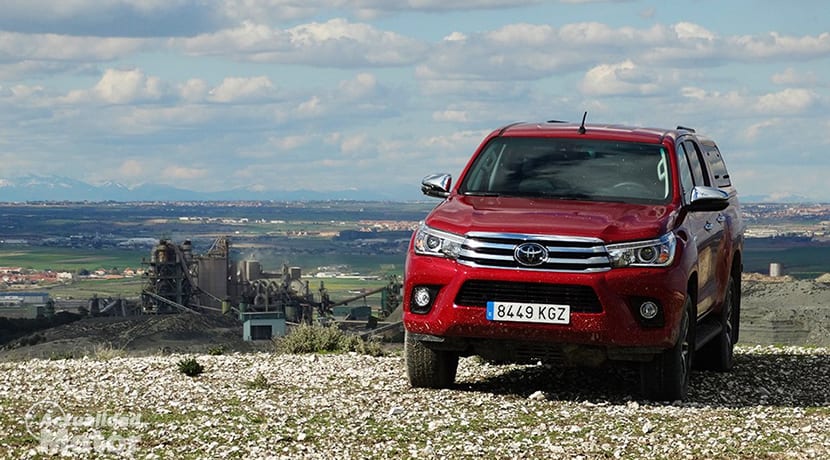
Otherwise, the Toyota Hilux is a Very robust pick-up with great aptitudes for off-road use. In this latest generation and it turns out to be more comfortable on the asphalt, but the rear leaf spring suspension continues to penalize it compared to the Navara. Of course, in terms of equipment and interior qualities is very successful.
Finally, let's take a look at what are the rivals of the Toyota Hilux, which are not few. For price, performance and capabilities, the models that most resemble this Japanese pick-up are the Ford Ranger, Mitsubishi L200, Nissan Navara and Volkswagen Amarok. The Mercedes X-Class is also a pick-up, but it has a much higher price.
Equipment Toyota Hilux
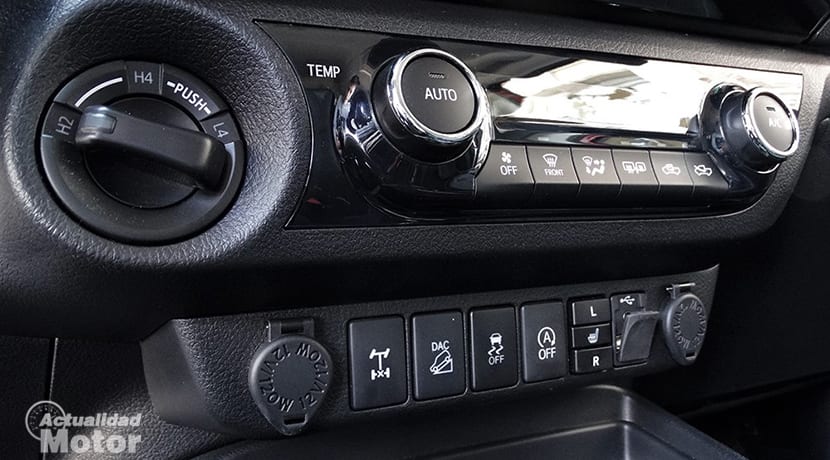
GX
- 7 airbags
- manual climate control
- CD/MP3 radio with USB and Aux input, 4 speakers and Bluetooth
- Automatic disconnecting front differential
- Locking rear differential
VX
- Reversing camera
- Cruise control
- descent control
- Alloy wheels in 17 inches
- Audio system with 6 speakers and 2-inch Toyota Touch 7 touch screen
VXL
- Automatic climate control
- Toyota Safety Sense
- 18-inch two-tone wheels
- rear parking sensor
- roll bars
- Side bars
- Lower bumper protection
Limited
- Heated Seats
- Keyless entry and start
- LED headlights
- Leather upholstery
- Driver's seat with electric adjustments
Toyota Hilux Prices
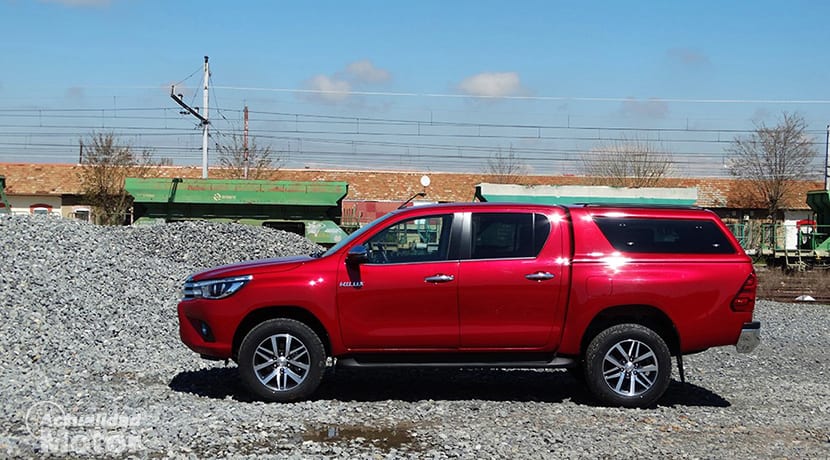
| Type | Version | Finish | Motor | Transfer | Price |
|---|---|---|---|---|---|
| Type | Version | Finish | Motor | Transfer | Price |
| Commercial use | Single cabin | GX | 2.4 D-4D 150 HP | manual 6v | 28.195 € |
| Commercial use | chassis single cab | GX | 2.4 D-4D 150 HP | manual 6v | 27.375 € |
| Commercial use | extra cabin | GX | 2.4 D-4D 150 HP | manual 6v | 29.245 € |
| Commercial use | Chassis extra cabin | GX | 2.4 D-4D 150 HP | manual 6v | 28.415 € |
| Commercial use | double cabin | GX | 2.4 D-4D 150 HP | manual 6v | 30.085 € |
| Commercial use | double cabin | VX | 2.4 D-4D 150 HP | manual 6v | 32.853€ |
| Commercial use | double cabin | VX | 2.4 D-4D 150 HP | automatic 6v | 34.703 € |
| Commercial use | double cabin | VXL | 2.4 D-4D 150 HP | manual 6v | 35.629 € |
| Commercial use | double cabin | VXL | 2.4 D-4D 150 HP | automatic 6v | 36.099 € |
| Commercial use | double cabin | Limited | 2.4 D-4D 150 HP | manual 6v | 37.003 € |
| Commercial use | double cabin | Limited | 2.4 D-4D 150 HP | automatic 6v | 38.868 € |
| Particular | Single cabin | GX | 2.4 D-4D 150 HP | manual 6v | 30.468 € |
| Particular | chassis single cab | GX | 2.4 D-4D 150 HP | manual 6v | 30.714 € |
| Particular | extra cabin | GX | 2.4 D-4D 150 HP | manual 6v | 31.603 € |
| Particular | Chassis extra cabin | GX | 2.4 D-4D 150 HP | manual 6v | 31.877 € |
| Particular | double cabin | GX | 2.4 D-4D 150 HP | manual 6v | 32.500 € |
| Particular | double cabin | VX | 2.4 D-4D 150 HP | manual 6v | 35.500 € |
| Particular | double cabin | VX | 2.4 D-4D 150 HP | automatic 6v | 37.500 € |
| Particular | double cabin | VXL | 2.4 D-4D 150 HP | manual 6v | 38.500 € |
| Particular | double cabin | VXL | 2.4 D-4D 150 HP | automatic 6v | 40.500 € |
| Particular | double cabin | Limited | 2.4 D-4D 150 HP | manual 6v | 40.000 € |
| Particular | double cabin | Limited | 2.4 D-4D 150 HP | automatic 6v | 42.000 € |
Editor's opinion

- Editor's rating
- 4 star rating
- Excellent
- Toyota Hilux Double Cab 150D Auto. Limited
- Review of: Diego Avila
- Posted on:
- Last modification:
- Exterior design
- interior design
- front seats
- rear seats
- Trunk
- Spring Suspension
- Consumption
- Comfort
- Price
Pros
- Exterior design
- internal quality
- off-road behavior
Cons
- Somewhat fair power for road
- Rear suspension rebounds
- engine noise






